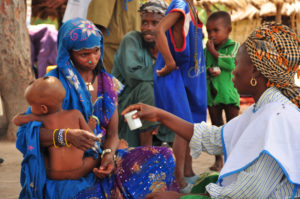Chad’s UN Network for SUN releases a UN Nutrition Agenda for reducing malnutrition in all of its forms
Undernutrition costs nearly 10 percent of GDP each year in Chad, according to the country’s Cost of Hunger Study (2015-2016). It can also lead to irreversible cognitive damage and contribute to both child morbidity and mortality. The levels of undernutrition levels are persistently high in…
Undernutrition costs nearly 10 percent of GDP each year in Chad, according to the country’s Cost of Hunger Study (2015-2016). It can also lead to irreversible cognitive damage and contribute to both child morbidity and mortality. The levels of undernutrition levels are persistently high in Chad, both acute and chronic forms of malnutrition, as well as micronutrient deficiencies, particularly in the zones of the Sahel, where the prevalence of child stunting exceeds 50%. These alarming levels are driven by a complex web of interlinked factors from food insecurity, to poor care practices, adolescent pregnancy, poor water and sanitation, limited access to health and social services, gender inequities, and socio-political challenges, underscoring the need for effective, efficient and coordinated action.
The development of the UN Nutrition Agenda for Chad (Agenda des Nations Unies pour la nutrition au Tchad [2018-2021]) is an opportunity to revisit and reaffirm the UN Network for SUN’s commitment to addressing malnutrition in the country. In Chad, FAO, UNFPA, UNICEF, WFP, and WHO are joining forces through the UN Network, with REACH facilitation support, to operationalise the ‘Deliver as One’ concept for nutrition.
The Agenda guides the UN Network’s work for achieving nutrition objectives defined by the National Nutrition and Food Policy (2014-2025), the Sustainable Development Goals (SDGs) and UNDAF (2017-2021). It recaps the national nutrition priorities to help frame how the UN Network will support Government efforts. The Agenda then stipulates five focus areas for UN Network activity in the next few years. Coordinating and harmonising UN nutrition actions is listed as one of these areas in order to employ a multi-sectoral approach, that links humanitarian and development work streams. To this end, the Agenda calls for joint UN programming, including joint implementation and monitoring on nutrition.
The intent is to translate policy and strategy gains into concrete action. It also articulates the need for contingency and transition plans to reinforce the emergency-development nexus. In addition, the Agenda also foresees broadening UN Network membership to all UN agencies engaging in nutrition with focal points identified for each region, particularly the emergency-affected Sahel localities. The Agenda also values knowledge capitalisation, including sharing good practices at the community level. Similarly, it acknowledges the need for institutional capacity building and systems strengthening to support scale-up.
The findings of the UN Nutrition Inventory (2016-2017) and the outcomes of strategic discussions at a UN Network retreat last year, where those findings were presented, served as a key inputs for articulating the common vision of the UN Nutrition Agenda. One finding revealed that about half of the thematic areas supported by the UN Network (seven out of fifteen) are carried out by three or more UN agencies. Some examples included: (1) infant and child young feeding (IYCF); (2) micronutrient supplementation; (3) hygiene; and (4) social safety nets (see Figure). The Inventory also identifies needs (including gaps) that the UN Network should address more effectively and efficiently. Here, the synergies and complementarities conferred through the UN Network will be crucial. It also highlights opportunities for increased multi-sectoral work, leveraging the comparative advantages of the respective UN agencies, in areas with a high stunting burden and to address challenges where stunting levels are moderate.
In addition, operational learning from implementing nutrition-specific and nutrition-sensitive interventions fed into the formulation process. The Agenda includes a series of indicators to measures success, leveraging those included in the national multi-sectoral nutrition plan (Plan Intersectoriel de Nutrition et d’Alimentation) and the World Health Assembly nutrition targets. The tenets of the Agenda will be reflected in the UN Network work plan, prepared on an annual basis, to ensure follow-through. It also identifies opportunities to strengthen ongoing collaboration with other SUN Networks, such as on nutrition advocacy with the Civil Society Network. While ambitious, the UN Network’s Nutrition Agenda is attainable with adequate resources, both human and financial.
• Read the Chad’s UN Nutrition Agenda
• Chad’s UN Nutrition Agenda for reducing malnutrition in all of its forms – UN Network for SUN

